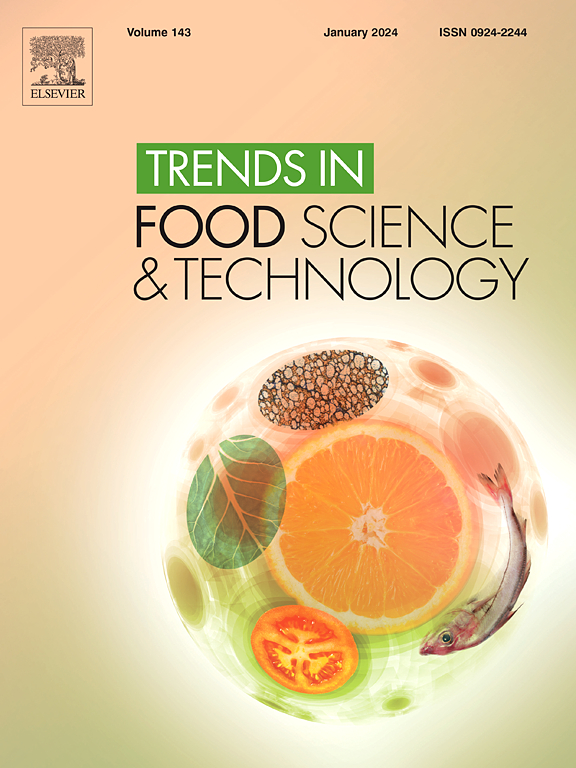食品/水中快速、灵敏、选择性病毒检测方法的系统综述
IF 15.1
1区 农林科学
Q1 FOOD SCIENCE & TECHNOLOGY
引用次数: 0
摘要
食品和水中的病毒检测是食品安全和公共卫生面临的重大挑战。诺瓦克病毒和肝炎病毒等食源性病毒是造成全球重大疫情的原因。可靠和快速的检测方法对于监测污染和预防感染至关重要。本系统综述评估了病毒检测技术的有效性,包括遗传、基于免疫测定、光学、测序和基于生物传感器的方法。文章选择遵循PRISMA 2020声明。评估了这些技术的准确性、精密度、准确度和选择性,比较了它们在食品和水基质中的性能。遗传方法,特别是RT-qPCR,由于其敏感性和标准化的协议,仍然是最可靠的方法。生物传感器显示了快速检测病毒的潜力,但需要进一步验证复杂的基质。新一代测序(NGS)提供了有价值的见解,但价格昂贵,并且未广泛用于常规分析。免疫测定法提供了一种替代方法,但在食品应用中面临限制。光学和新兴技术,如分子印迹聚合物和适体,为提高速度和选择性提供了有希望的途径。总的来说,虽然RT-qPCR是目前的金标准,但生物传感器和替代技术的进步可能会在未来实现更快,更具选择性和成本效益的病毒检测。需要进一步的研究来优化这些技术以用于实际的食品安全应用。本文章由计算机程序翻译,如有差异,请以英文原文为准。
Towards fast, sensitive, and selective viral detection methods in food/water: a systematic review
Background
Viral detection in food and water is a major challenge for food safety and public health. Foodborne viruses such as noroviruses and hepatitis viruses are responsible for significant outbreaks worldwide. Reliable and rapid detection methods are essential for monitoring contamination and preventing infections.
Scope and approach
This systematic review evaluates the effectiveness of viral detection techniques, including genetic, immunoassay-based, optical, sequencing, and biosensor-based methods. The PRISMA 2020 statement was followed for article selection. The techniques were assessed based on trueness, precision, accuracy, and selectivity to compare their performance in food and water matrices.
Key findings and conclusion
Genetic methods, particularly RT-qPCR, remain the most reliable approach due to their sensitivity and standardized protocols. Biosensors show potential for rapid viral detection but require further validation for complex matrices. Next-generation sequencing (NGS) provides valuable insights but is costly and not widely adopted for routine analysis. Immunoassays offer an alternative but face limitations in food applications. Optical and emerging techniques such as molecularly imprinted polymers and aptamers present promising avenues for improving speed and selectivity. Overall, while RT-qPCR is the current gold standard, advances in biosensors and alternative techniques may enable faster, more selective, and cost-effective viral detection in the future. Further research is needed to optimize these technologies for real-world food safety applications.
求助全文
通过发布文献求助,成功后即可免费获取论文全文。
去求助
来源期刊

Trends in Food Science & Technology
工程技术-食品科技
CiteScore
32.50
自引率
2.60%
发文量
322
审稿时长
37 days
期刊介绍:
Trends in Food Science & Technology is a prestigious international journal that specializes in peer-reviewed articles covering the latest advancements in technology, food science, and human nutrition. It serves as a bridge between specialized primary journals and general trade magazines, providing readable and scientifically rigorous reviews and commentaries on current research developments and their potential applications in the food industry.
Unlike traditional journals, Trends in Food Science & Technology does not publish original research papers. Instead, it focuses on critical and comprehensive reviews to offer valuable insights for professionals in the field. By bringing together cutting-edge research and industry applications, this journal plays a vital role in disseminating knowledge and facilitating advancements in the food science and technology sector.
 求助内容:
求助内容: 应助结果提醒方式:
应助结果提醒方式:


